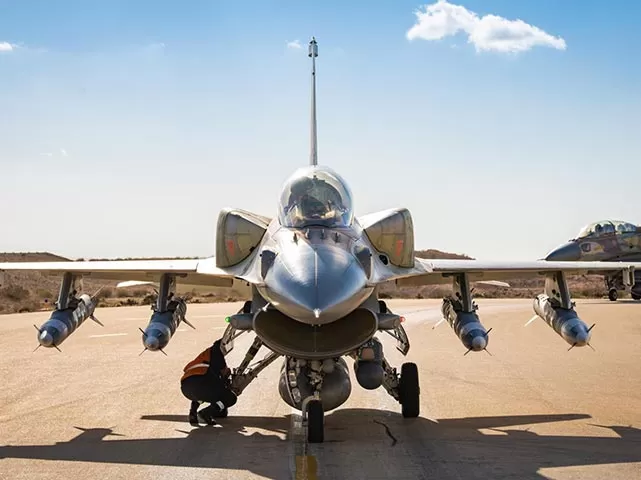
RAMPAGE Delivers Where Others Can't
In a battlefield where UAVs and drones are becoming more popular, is there still room for precision-guided munitions launched from fighter jets? Elbit Systems' new ballistic air-to-ground missile proves there is.
With the rise of UAS platforms, including UAVs and drones, becoming more popular on the modern battlefield and with increasing efforts to counter them, one might say that the more traditional platforms – like fighter jets and heavy precision munitions – seem to be sidelined.
But is this truly the end of an era in aerial warfare? Or are there still missions where only fighter jets can deliver maximum effectiveness, despite their higher operational costs?
A senior official from Elbit Systems offers new insights into the integration of fighter jets and precision ballistic missiles in modern aerial warfare.
He argues that it's premature to dismiss these operational capabilities, as they remain crucial in conventional military engagements – even against guerrilla forces, militias, and armed terrorist groups.
Back to the Classics
There is still an important operational impact to the air-to-ground classic munitions deployed from manned fighter jets. While drones or artillery shells are effective for specific missions, it can't compare to the operational impact of a bomb dropped from a fighter jet. There’s no substitute for that capability, and it doesn’t seem like one will emerge anytime soon.
When attacking an enemy’s strategic infrastructure, for example, light munitions probably won’t cut it. You need to ensure the mission is completed with maximum precision and effectiveness.
Even in asymmetric warfare, like against terrorist organizations hiding underground, powerful bunker-buster bombs are highly effective. These capabilities remain important for many of Elbit Systems' clients.
Enter the RAMPAGE
To address this operational need, Elbit Systems developed the RAMPAGE missile, an air-to-ground weapon launched from fighter jets. Weighing 580KGs, with almost 5 meters in length and 306mm diameter – this long-range precise air-to-ground supersonic missile is a lethal add-on to the scene.
The missile was primarily designed to counter long-range surface-to-air missile systems and take out anti-aircraft batteries deep within enemy territory. Capable of reaching supersonic speeds of Mach 5, the RAMPAGE missile is hard to intercept. That’s one of the key advantages of ballistic missiles like this.
This raises the question: why launch a ballistic missile from a fighter jet rather than a ground-based launcher? “We adapted the missile from a similar ground system, transforming it into an air-to-ground missile,” explains the senior official. “When launched from a high altitude by a fighter jet, the missile's range is considerably extended.”
Additionally, deploying such a heavy munition from an airborne platform that can carry such weight offers operational flexibility not possible with ground-based launches. If you need to strike a strategic target from a safe distance without crossing enemy lines, the RAMPAGE is a valuable tool.
Beyond its impressive range, the missile’s warhead and precision are remarkable with GPS guidance systems and it is highly resistant to disruption from electronic warfare tools.
New Attack Options
A variety of clients worldwide are already showing interest in and purchasing the RAMPAGE missile, thanks in part to Elbit Systems' ability to adapt the missile to various flying platforms. “We offer integration and support services to equip the missile and its advanced computing systems on a wide range of aircraft and fighter jets,” the senior official explains. “Our process is efficient and effective in achieving safe deployment.”
Many militaries worldwide, especially those with significant air forces, recognize that despite the growing threat of drones and UAVs, there is no substitute for the powerful strike of a ballistic missile launched from a fighter jet.
"The clients interested in this missile already understand the importance of a strong air force, especially with the escalating conflicts around the world," the official concludes. "Our developments are focused on giving them the ability to strike previously hard-to-reach targets, and we will keep advancing these capabilities."
The content of the article does not constitute business or financial information about Elbit Systems Ltd. (the "Company") and is not intended to be a basis for making investment decisions in the Company's securities. In order to obtain business or financial information about the Company, please refer to the reports and filings that the Company regularly publishes on the website of the U.S Securities and Exchange Commission (EDGAR) and on the notification system of the Tel Aviv Stock Exchange (Maya).
The article may contain forward-looking statements such as estimates, forecasts, estimates, plans, etc. that refer to future events that are considered forward-looking information as defined under the securities laws of Israel and the United States. There is no certainty that such information will be realized, in whole or in part, and the actual result may differ from what was presented in the article, among other things due to its dependence on external factors that are not under the control of the Company and that cannot be evaluated in advance. The forward-looking statements are based on the Company's estimates at the time of publication, and the Company has no obligation to update or correct this data.

